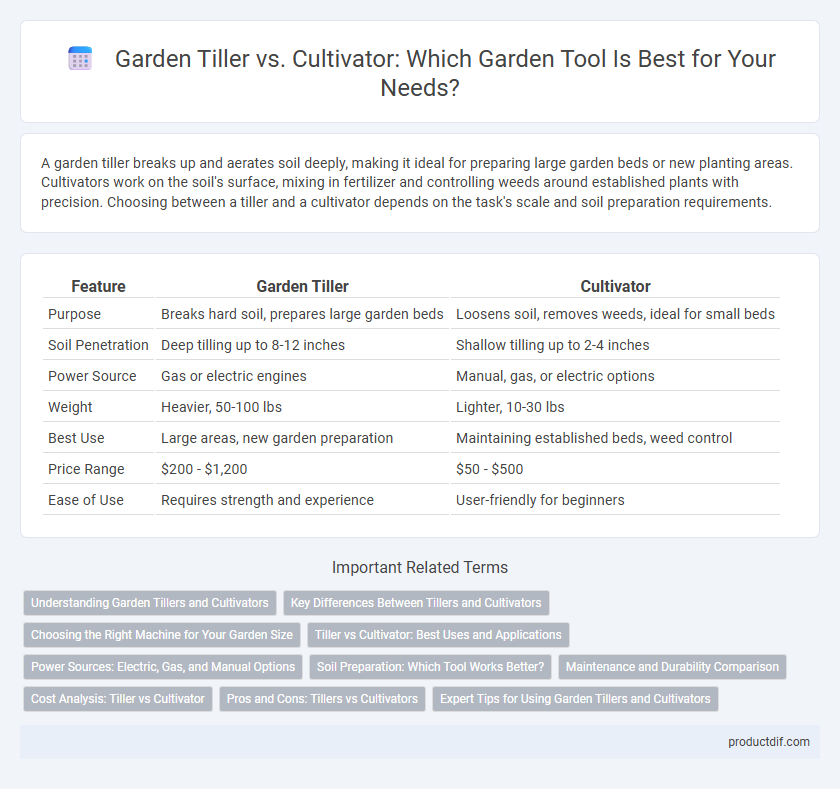A garden tiller breaks up and aerates soil deeply, making it ideal for preparing large garden beds or new planting areas. Cultivators work on the soil's surface, mixing in fertilizer and controlling weeds around established plants with precision. Choosing between a tiller and a cultivator depends on the task's scale and soil preparation requirements.
Table of Comparison
| Feature | Garden Tiller | Cultivator |
|---|---|---|
| Purpose | Breaks hard soil, prepares large garden beds | Loosens soil, removes weeds, ideal for small beds |
| Soil Penetration | Deep tilling up to 8-12 inches | Shallow tilling up to 2-4 inches |
| Power Source | Gas or electric engines | Manual, gas, or electric options |
| Weight | Heavier, 50-100 lbs | Lighter, 10-30 lbs |
| Best Use | Large areas, new garden preparation | Maintaining established beds, weed control |
| Price Range | $200 - $1,200 | $50 - $500 |
| Ease of Use | Requires strength and experience | User-friendly for beginners |
Understanding Garden Tillers and Cultivators
Garden tillers and cultivators are essential tools for soil preparation, with tillers designed to break up hard soil and cultivate large areas efficiently, while cultivators focus on loosening soil and removing weeds in smaller plots. Tillers typically feature larger, heavier tines for deep soil penetration, making them ideal for initial ground breaking in garden beds. Cultivators, often lighter and more maneuverable, excel at aerating soil around plants and maintaining garden rows without damaging roots.
Key Differences Between Tillers and Cultivators
Garden tillers feature larger, more powerful engines and robust tines designed to break and turn over hard, compact soil, making them ideal for initial soil preparation. Cultivators have smaller, lighter tines optimized for mixing soil and removing weeds in already loosened soil beds. The primary difference lies in their intended use: tillers are for heavy-duty soil breaking, while cultivators serve for fine soil aeration and weed control.
Choosing the Right Machine for Your Garden Size
Garden tillers are ideal for large garden areas, efficiently breaking up compact soil and preparing vast beds for planting. Cultivators excel in smaller gardens, maintaining soil aeration and controlling weeds without disturbing established plants. Selecting the right machine depends on garden size and soil condition, ensuring optimal soil preparation and ease of use.
Tiller vs Cultivator: Best Uses and Applications
Garden tillers are ideal for breaking new ground and turning large soil areas to prepare for planting, efficiently loosening hard or compacted soil. Cultivators excel in maintaining established garden beds by aerating soil, controlling weeds, and mixing in soil amendments without disturbing plant roots. Choosing between a tiller and cultivator depends on the scale of soil preparation and ongoing garden maintenance needs.
Power Sources: Electric, Gas, and Manual Options
Garden tillers and cultivators are available with various power sources including electric, gas, and manual options, each suited to different gardening needs. Electric models provide quiet operation and low maintenance, ideal for small to medium-sized gardens, while gas-powered machines deliver more power for heavy-duty soil breaking and larger garden plots. Manual tools, favored for their eco-friendliness and precision, are perfect for gardeners seeking low-impact, close-to-the-root soil aeration.
Soil Preparation: Which Tool Works Better?
Garden tillers break up compacted soil deeply, making them ideal for initial soil preparation and large garden plots. Cultivators work best for shallow soil aeration and weed control between rows, preserving soil structure. For thorough soil preparation, tillers offer more effective penetration and mixing of soil amendments.
Maintenance and Durability Comparison
Garden tillers and cultivators both require regular maintenance to ensure optimal performance, with garden tillers typically demanding more attention due to their heavier-duty construction and powerful engine components. Cultivators generally feature simpler mechanics, making them easier and less costly to maintain over time, while garden tillers offer greater durability for breaking tough soil but may need more frequent part replacements, such as tines or belts. Investing in high-quality brands and proper cleaning, lubrication, and storage practices significantly enhances the longevity and reliability of both garden tillers and cultivators.
Cost Analysis: Tiller vs Cultivator
Garden tillers typically cost between $300 and $1,200, reflecting their larger size and higher horsepower suitable for breaking new ground. Cultivators generally range from $100 to $500, designed for lighter soil aeration and weed control in established gardens. Investing in a tiller offers durability and power for extensive soil preparation, while cultivators provide an affordable option for maintaining beds with less intensive labor.
Pros and Cons: Tillers vs Cultivators
Garden tillers offer powerful soil aeration and deep turning capabilities, making them ideal for breaking new ground and preparing large garden plots. Cultivators excel at shallow soil cultivation, weed control, and mixing in compost, providing precise soil management for established gardens. While tillers are generally heavier and require more effort to operate, cultivators are lighter and more maneuverable, but less effective for deep soil preparation.
Expert Tips for Using Garden Tillers and Cultivators
Garden tillers are designed for breaking up hard soil and preparing large garden beds, while cultivators excel at aerating soil and controlling weeds within established gardens. Experts recommend using tillers to thoroughly loosen compacted soil before planting, and cultivators to maintain soil health by gently turning the top layer without disturbing plant roots. Selecting the right tool based on soil conditions and garden size enhances plant growth and maximizes efficiency during garden maintenance.
Garden tiller vs Cultivator Infographic

 productdif.com
productdif.com